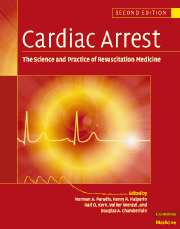Book contents
- Frontmatter
- Contents
- List of contributors
- Foreword
- Preface
- Part I Introduction
- Part II Basic science
- Part III The pathophysiology of global ischemia and reperfusion
- Part IV Therapy of sudden death
- Part V Postresuscitation disease and its care
- Part VI Special resuscitation circumstances
- 52 Prevention of sudden death in patients at risk: channelopathies and arrhythmic syndromes in the structurally normal heart
- 53 Pediatric cardiopulmonary resuscitation
- 54 Resuscitation in elder persons
- 55 Asphyxial cardiac arrest
- 56 Hemorrhagic shock and hypovolemic cardiac arrest
- 57 Cardiopulmonary resuscitation in hypothermic patients
- 58 Cardiac arrest due to poisoning
- 59 Cardiac arrest during anesthesia
- 60 Resuscitation of the pregnant patient suffering sudden cardiac death
- 61 Drowning
- 62 Anaphylactic shock
- 63 High altitude resuscitation
- 64 Electrical injuries
- 65 Rare syndromes, commotio cordis, sudden death in athletes
- Part VII Special issues in resuscitation
- Index
64 - Electrical injuries
from Part VI - Special resuscitation circumstances
Published online by Cambridge University Press: 06 January 2010
- Frontmatter
- Contents
- List of contributors
- Foreword
- Preface
- Part I Introduction
- Part II Basic science
- Part III The pathophysiology of global ischemia and reperfusion
- Part IV Therapy of sudden death
- Part V Postresuscitation disease and its care
- Part VI Special resuscitation circumstances
- 52 Prevention of sudden death in patients at risk: channelopathies and arrhythmic syndromes in the structurally normal heart
- 53 Pediatric cardiopulmonary resuscitation
- 54 Resuscitation in elder persons
- 55 Asphyxial cardiac arrest
- 56 Hemorrhagic shock and hypovolemic cardiac arrest
- 57 Cardiopulmonary resuscitation in hypothermic patients
- 58 Cardiac arrest due to poisoning
- 59 Cardiac arrest during anesthesia
- 60 Resuscitation of the pregnant patient suffering sudden cardiac death
- 61 Drowning
- 62 Anaphylactic shock
- 63 High altitude resuscitation
- 64 Electrical injuries
- 65 Rare syndromes, commotio cordis, sudden death in athletes
- Part VII Special issues in resuscitation
- Index
Summary
Today, human-made and natural sources together kill about 1100 to 1200 people each year in the United States. The number of people injured worldwide by electricity, however, remains unclear, because it is generally underreported and it is common for survivors to avoid medical care initially. Although scientific investigations of electrical injuries date back to 1884, with current scientific knowledge and the clinical appearance of electrical injuries, we now know that the outcomes of electrical injuries differ substantially, depending on whether technical electricity with low-volt household current, high-volt current, or lightning is the underlying cause.
Injuries after electrocution are often dramatic and potentially fatal. In the majority of victims injuries are caused by the effects of electrical, thermal, and mechanical energy. Secondary trauma may result from falls, explosions, or violent muscle contractions. Cardiac and respiratory arrest may occur immediately or secondary to direct effects of current. Many victims die before advanced life support can be provided, and survivors may suffer permanent disabilities. What is unique about electrical injuries, however, is the potential for good resuscitation outcome even after long arrest times. This may be a result of the electrical shock itself or because these accidents tend to occur in younger persons with few or no underlying pathological conditions.
Considering the magnitude of the voltage and current involved, it is amazing that anyone survives an encounter with a bolt of lightning. Lightning can cause harm by electrical energy (e.g., direct hit, side splash, upward streamer, ground strike, conducted current, step voltage) and can cause trauma (e.g., heat, explosion, fall).
- Type
- Chapter
- Information
- Cardiac ArrestThe Science and Practice of Resuscitation Medicine, pp. 1136 - 1147Publisher: Cambridge University PressPrint publication year: 2007



